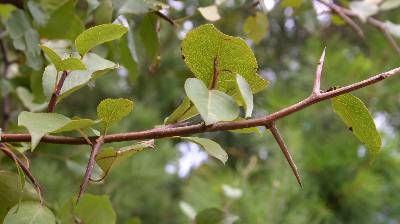Thorny trees are characterized by the presence of large, pointed spikes or barbs on their trunks and stems. These spikes can pose a hazard as they have the potential to cause harm if touched. Some trees may even have thorns that are hidden beneath leaves or difficult to spot in the crevices of branches and twigs.
Among the well-known trees with thorns are the locust tree, acacia tree, hawthorn tree, and floss silk tree. Locust trees, for example, have clusters of sharp spikes on their trunks, while the floss silk tree has jagged protrusions running up its straight trunk. Hawthorn trees, on the other hand, feature sparse needle-like thorns along their slender branches.
It is important to be aware of the different types of thorny trees and how to identify them without getting too close. The sharp barbs can penetrate shoes and pose a danger to people. This article provides photos and descriptions of these thorny trees, making it easier to recognize their spiky growth patterns and other distinctive features in a landscape.
What Are Trees With Thorns?
Trees that have tall structures and feature thorny bark, stems, or branches are commonly known as thorny trees. These trees can have a prickly appearance due to the presence of barbed growths that form small clusters. Sharp thorns may also develop along slender twigs, either individually or in a solitary manner. Examples of thorny trees include the acacia tree, which has a spreading crown, and the hawthorn tree, which is more shrub-like in size.
While some people may use the term “thorns” to refer to sharp and jagged leaves on trees and shrubs, this page specifically focuses on trees that exhibit spikes, thorns, or barbs on their bark or twigs. So, it excludes discussion of plants with prickly leaves such as the holly tree and Oregon grape holly shrub.
Thorns vs. spines vs. prickles
The terms “thorns,” “spines,” and “prickles” are commonly used interchangeably, but they actually have slight distinctions. Thorns are modified shoots and can be found on trees like the honey locust or hawthorn tree. Prickles, on the other hand, are sharp spikes that arise from the plant’s bark, as seen on a rose bush. Spines, similar to those found on a holly or barberry bush, develop from leaf tissues. While all three serve as protective structures for the plants, they differ in their origins and the parts of the plant from which they arise.
How to Handle Thorny Trees
Managing thorny trees in a garden can present challenges. Pruning these trees requires careful attention and approaching them necessitates caution. It is advisable to wear appropriate footwear that provides protection against slipping. To ensure personal safety and avoid cuts or punctures, it is recommended to wear sturdy gloves and safety goggles. These protective measures will help mitigate potential risks when dealing with thorny trees.
How to Identify Trees With Thorns
Identifying thorny trees involves closely observing their growth characteristics. Factors such as the shape and height of the crown, the shape of the leaves, and the presence of flowers should all be taken into account. Paying attention to the size and length of the tree’s thorny spikes can also aid in identification when examining it up close. By considering these features, one can effectively recognize and differentiate thorny trees.
Trees With Thorns (With Pictures) — Identification Guide
Let’s examine the 14 species of thorny trees that may grow in a garden in further detail.
Acacia Tree (Acacia)

Acacia trees and shrubs come in various sizes and are well-adapted to thrive in dry and arid environments. They are characterized by their distinctive flat-topped and spreading crowns, which are adorned with pinnate leaves composed of small oval leaflets. These trees also produce small flowers. In arid regions, acacia trees often display clusters of sharp spikes on their branches, serving as a unique feature of their growth in such challenging conditions.

Acacia trees develop between 13 to 20 feet (4 to 6 meters) tall with a 26-foot (8-meter) diameter umbrella-shaped canopy. Because they tolerate drought and hot sunlight, these trees are well suited to growing in the desert. Acacia trees are also known as thorntrees, mimosas, or wattle trees.

Acacia thorns in a close-up shot
Thorny tree identification
Acacia trees are easily recognized by their unique features. They possess grayish-white, pointed spurs that grow in pairs along their crimson-brown branches. The leaves of acacia trees resemble those of the mimosa plant, adding to their distinct appearance. These characteristics make it relatively easy to identify acacia trees in their natural habitat.
Honey Locust Tree (Gleditsia triacanthos)

The honey locust tree is a large, fast-growing deciduous tree with a trunk adorned by massive, branching thorns. These thorns are sharp and formidable, adding to the tree’s distinctive appearance. Other characteristics of the locust tree include pinnately compound leaves, long reddish-brown seed pods, and small clusters of greenish-yellow flowers. These features collectively help in identifying the honey locust tree in its natural environment.

The honey locust tree is a sizable and wide-spreading tree that can reach heights of 60 to 80 feet (18 to 24 meters). It is characterized by its formidable spikes, which can grow up to 3 inches (7.5 cm) in length and possess exceptional sharpness. The distinctive feathery leaves of the honey locust resemble those of the mimosa plant, composed of small oval leaflets. During the autumn season, the honey locust tree undergoes a transformation, shedding its leaves and turning a beautiful golden yellow. These features make the honey locust tree easily recognizable and add to its unique charm.

Honey locust trees are not commonly recommended for residential landscapes due to their challenging bark and thorns, which can be difficult to remove. However, there are thornless cultivars, such as Gleditsia triacanthos var. inermis, that are available for those who prefer a safer option. When identifying the honey locust tree, its distinctive feature is the presence of stout and needle-sharp thorns, some of which can grow to be over 8 inches (20 cm) in length. During the summer months, the pinnately compound leaves of the tree exhibit a vibrant green color, which transitions to a yellow hue in the autumn season.
Black Locust (False Acacia) Tree (Robinia pseudoacacia)

The black locust tree is a small, thorned deciduous tree that grows to be about 3 feet tall. The suckering of the shrub-like tree is prolific, and it is a weed. The pinnately compound leaves of the black locust are dangling with white pea-like blooms, and the flattened seed pods are reddish-brown.
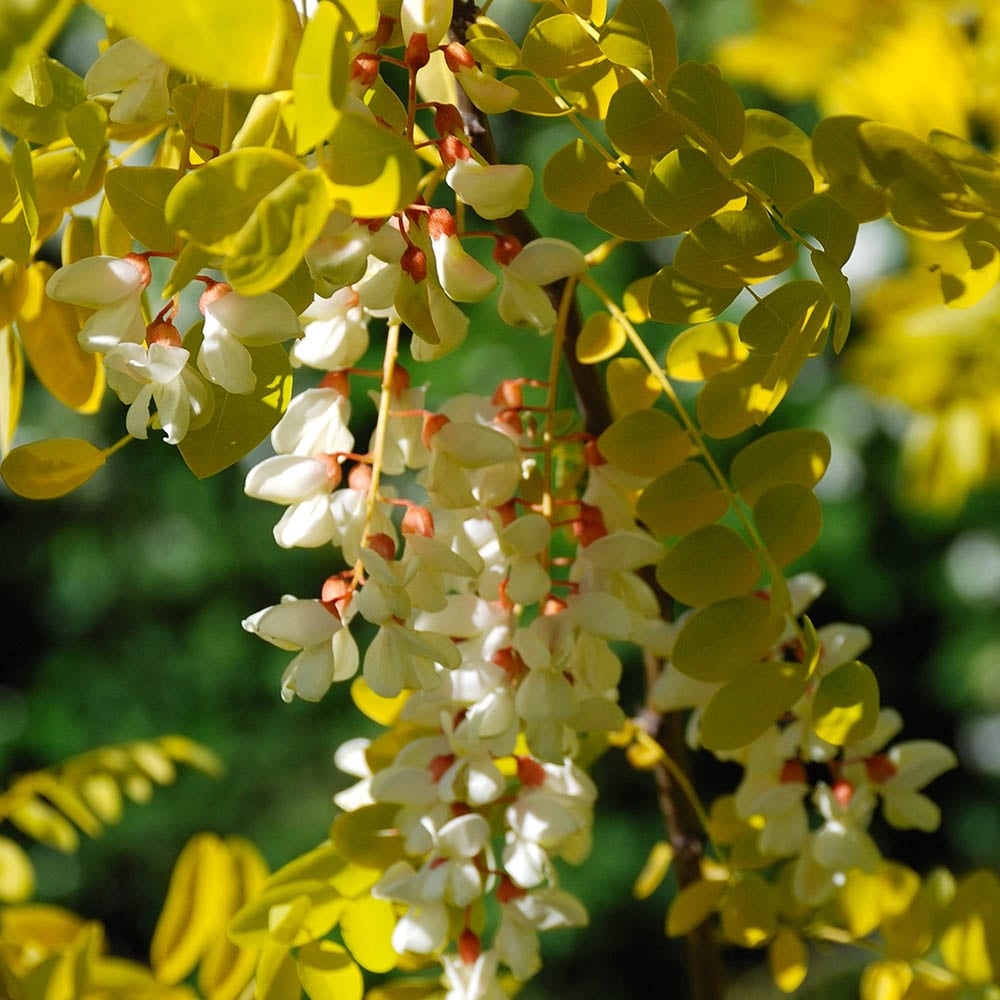
Black locust trees may grow up to 35 feet (10.5 meters) tall and broad, with thorny branches and black leaves. Each of the pinnately complex leaves has 7 to 21 leaflets and grows 8 to 14 inches (20 to 35 cm) long. The 8″ (20 cm) long white flower clusters produce long seed pods that are showy and fragrant like wisteria.

Black locust trees are best suited for areas with full sun or partial shade, and they require well-drained soil and sufficient water to thrive in USDA zones 3 to 9.
When identifying black locust trees, you can look for their distinctive features, such as thorny and brittle branches, dark brown to black furrowed bark, and beautiful white flowers that emit a pleasant fragrance.
Hawthorn Tree (Crataegus)

Hawthorn trees are characterized by their bark and branches adorned with sharp-tipped thorns. These thorns can be multiple-branched, making them even more formidable. The leaves of hawthorn trees resemble parsley leaves, with small oval shapes and deep lobes. Adding to their beauty, hawthorn trees and shrubs produce large clusters of creamy-white flowers.

Hawthorn encompasses both tall thorny shrubs and small spiked trees, offering a range of sizes. These prickly trees can grow as tall as 15 feet (5 meters), showcasing their defensive nature. In late May or early June, the hawthorn tree blooms with flat-topped clusters of fragrant flowers, adding a touch of beauty to its rugged exterior. The hawthorn tree also boasts stiff thorns, typically measuring between 1 to 3 inches (2.5 – 7.5 cm) in length.
Furthermore, ornamental hawthorn trees display a captivating foliage transformation throughout the seasons. In the spring, their leaves emerge in a reddish-purple hue, transitioning to green during the summer. As autumn arrives, the leaves showcase a stunning array of colors, ranging from brilliant red and purple to vibrant orange.

Hawthorn flowers
Thorny tree identification
The rounded, spreading crown of a hawthorn tree, masses of white spring blooms, and red berry-like drupes in the autumn are all characteristics. Hawthorn tree branches also feature 1-inch (2.5 cm) or longer spiky thorns, which are characteristic of the species.

Hawthorn berries
Mesquite Tree (Prosopis)

Mesquite trees exhibit a diverse range of varieties, often displaying a small, multi-stemmed structure adorned with sharp, pointed thorns along their branches. These thorns, resembling nails, can grow up to 3 inches (7.5 cm) in length and pose a piercing threat if handled carelessly. During the spring and summer seasons, mesquite trees burst into vibrant clusters of fuzzy, yellowish flowers, forming distinct spikes. As these flowers transition, they give rise to dangling bean pods, further enhancing the unique appearance of the tree.
Mesquite trees can reach heights and widths of up to 26 feet (8 meters), with the specific Prosopis juliflora species depicted in the photograph. Notable features that distinguish mesquite trees include their crooked branches, feathery pinnately compound leaves, and the presence of paired, robust thorns.

Mesquite trees possess intricately structured pinnate leaves that are well-suited for thriving in arid desert environments. These tiny, shrub-like trees exhibit deep taproots, endowing them with exceptional heat tolerance. Mesquite trees can serve as valuable additions to residential landscapes, whether utilized as shade trees or ornamental features in lawns. For those who prefer a thornless variety, such options are also available for cultivation.
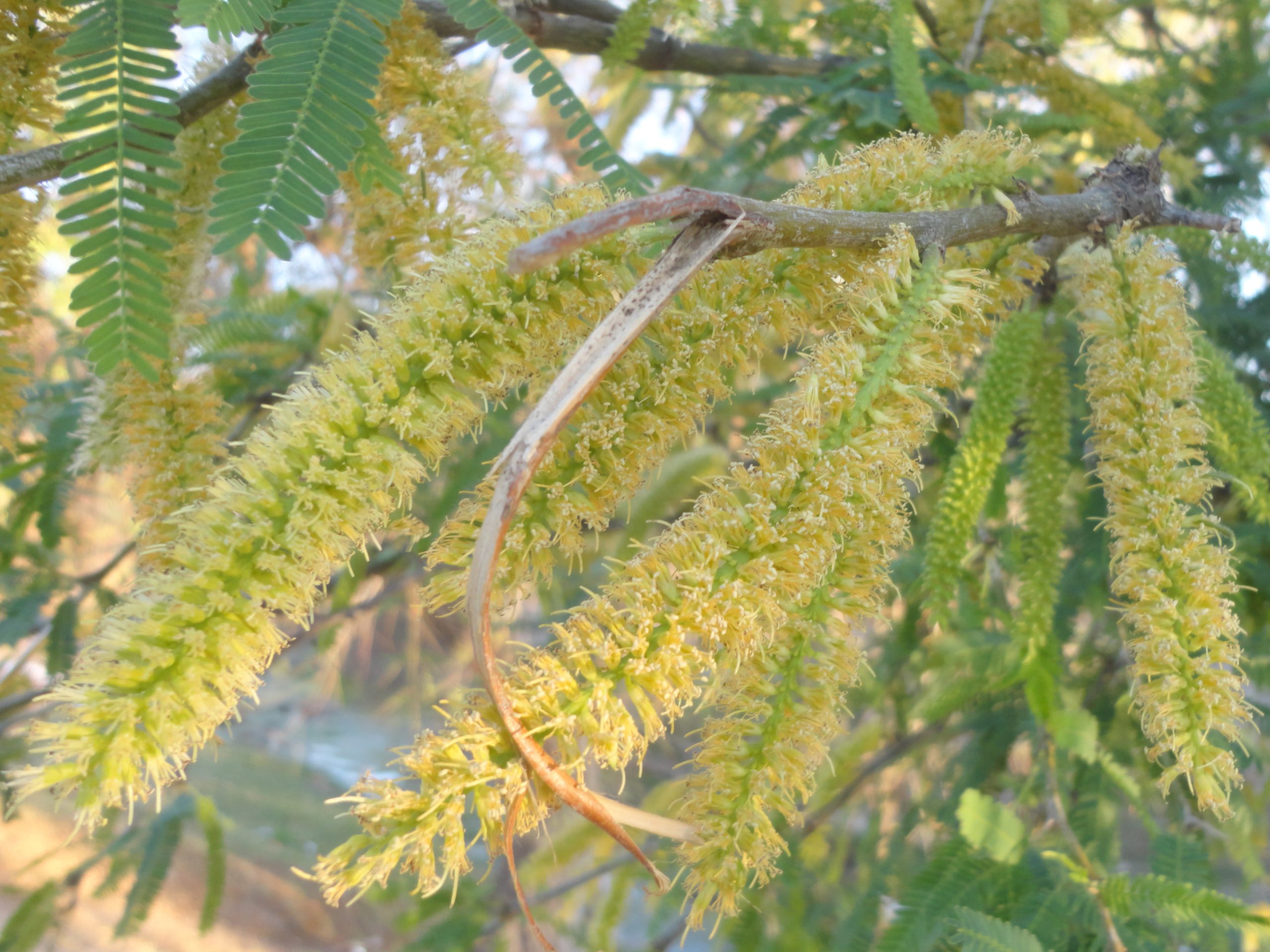
Smooth mesquite (Prosopis laevigata) blooms bloom in the Mesquite flowers image.
Thorny tree identification
Mesquite trees have yellowish-brown pointed thorns, bipinnately compound leaves, and yellow blooming spikes that differentiate them from other trees.
Palo Verde Tree (Parkinsonia)
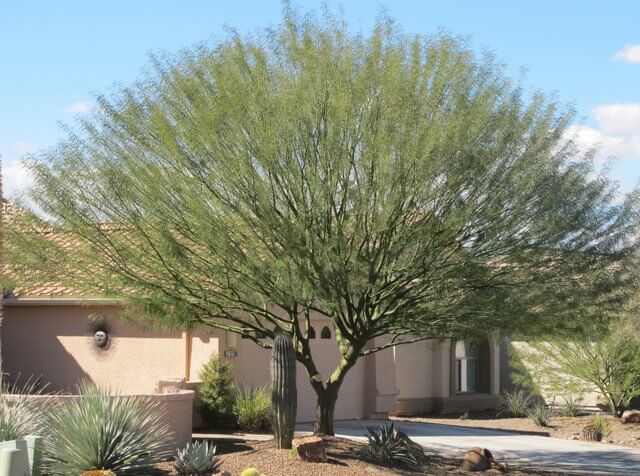
Palo verde trees, scientifically known as Parkinsonia aculeata, are small tropical trees characterized by their upright growth and adorned with prickly branches. These trees are easily recognized by their vibrant yellow and orange flowers, which put on a stunning display throughout the summer months. Palo verde trees thrive in USDA zones 8 to 11, showcasing their beauty in these regions.
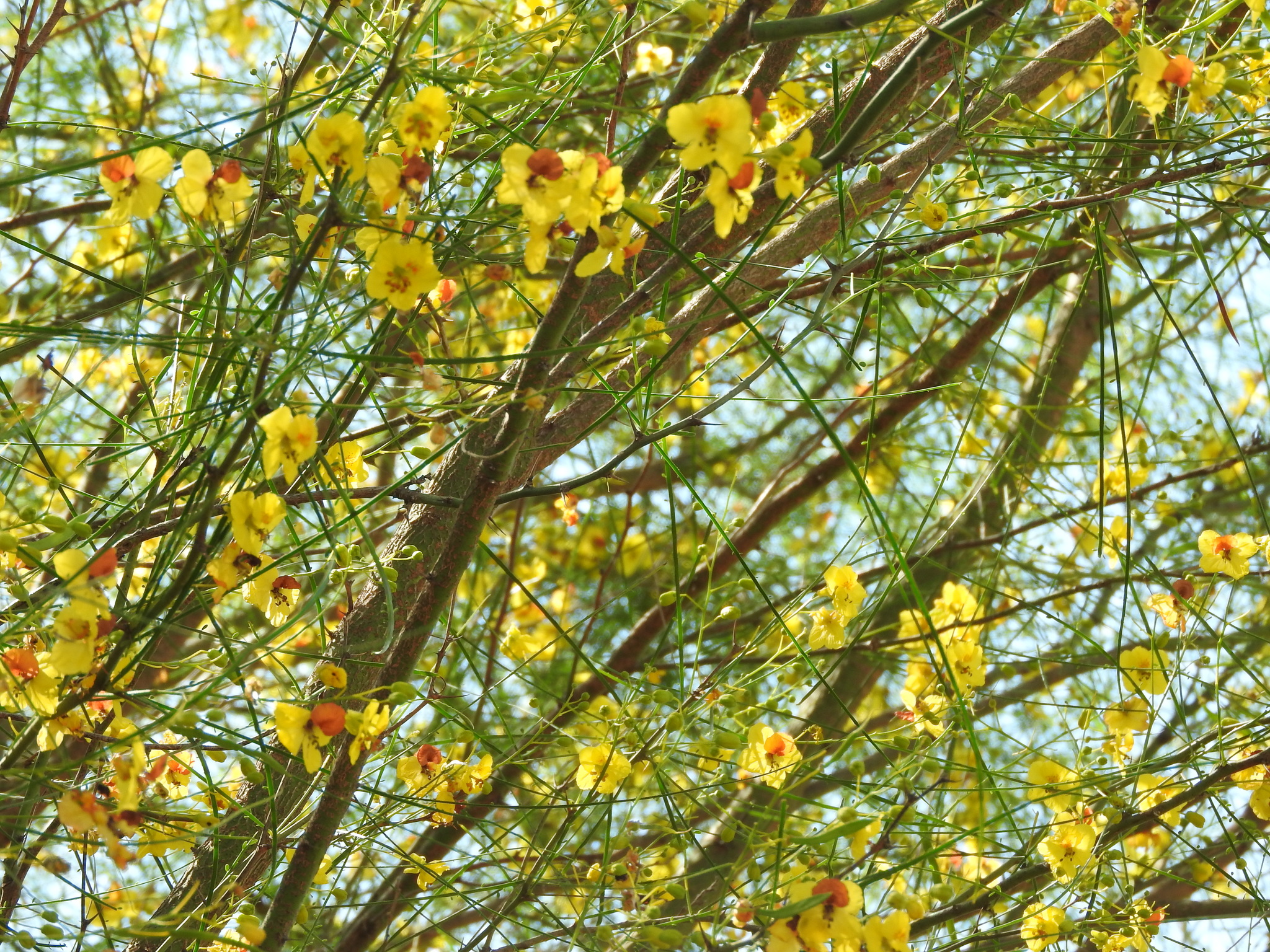
Palo verde trees are known for their distinctive upright branching pattern and vase-shaped appearance, reaching heights of 16 to 40 feet (5 to 12 meters). These trees, with their heat-tolerant nature, showcase vibrant yellow flowers that bloom during periods of rain, even though they shed their bipinnately compound leaves in dry summers. As a result, dense thickets of small palo verde bushes often form, adding to the unique charm of these trees.

Parkinsonia aculeata leaves are used in Palo Verde.
Thorny tree identification
The palo verde tree can be recognized by its yellow blossoms adorned with orange patches, elongated bean pods that reach up to 5 inches (12 cm) in length, and the presence of sharp barbs growing along its branches. These distinctive features contribute to the unique appearance of the palo verde tree.

(Parkinsonia aculeata) Palo verde blooms
Floss Silk Tree (Ceiba speciosa)
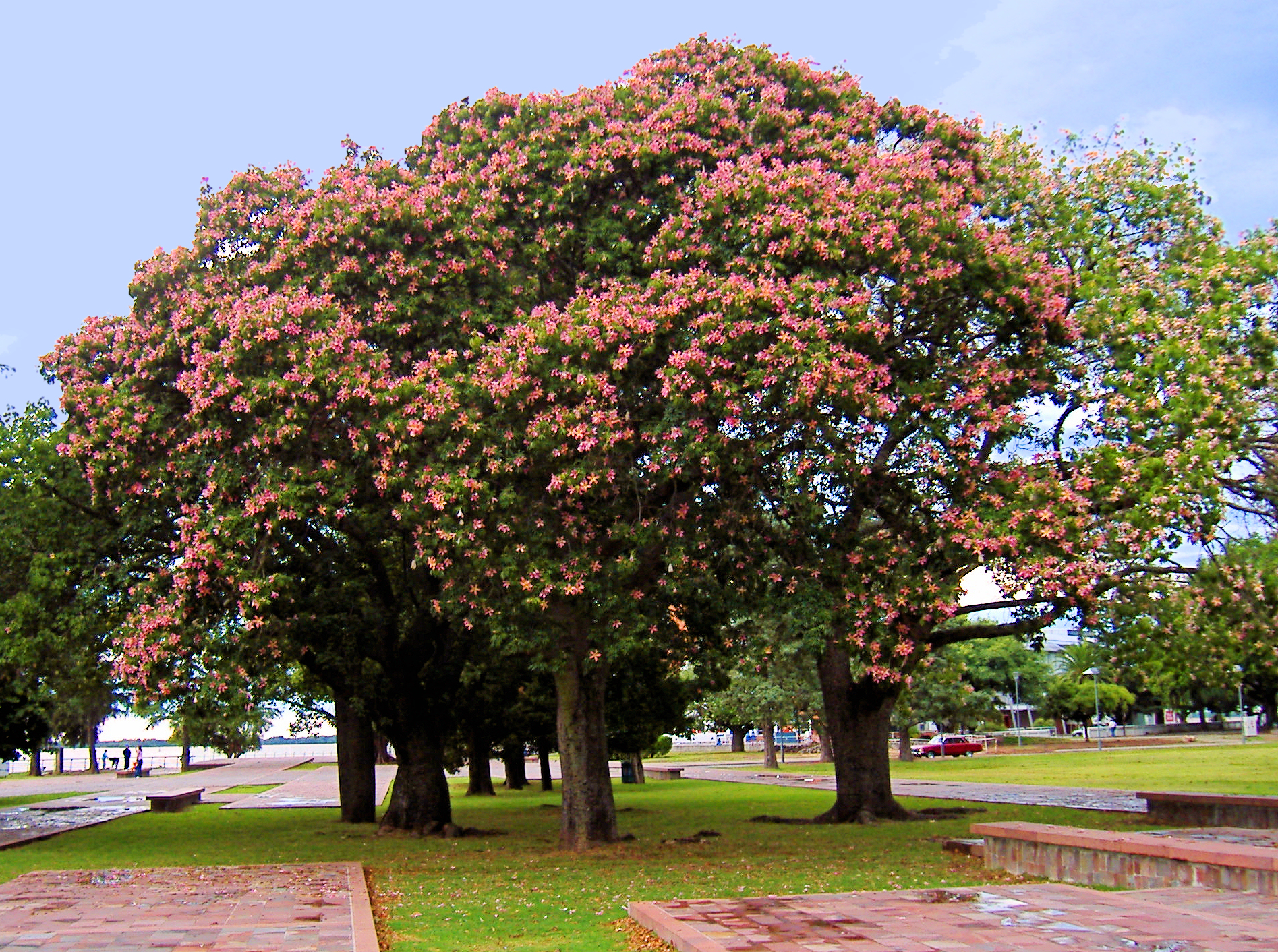
The floss silk tree, scientifically named Ceiba speciosa, features a unique bottle-shaped trunk that expands near the base, giving it a distinctive appearance. The tree produces stunning pink flowers with five-lobed petals that form a star shape, measuring around 4 to 6 inches (10 to 15 cm) in diameter. The dark green leaves complement the vibrant blooms, creating a visually striking display.

Thorny tree identification
Because of the grayish conical prickles that cover the cylindrical green stem, the floss silk tree is readily recognized.
Sandbox Tree (Hura crepitans)
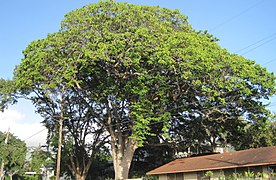
The smooth brown bark of the sandbox tree is covered in extremely sharp, pyramid-shaped pointed prickles. It is an evergreen tree with a thorny trunk. Several unusual growth characteristics distinguish this tropical tree. Little red petal-less blooms, huge ovate leaves up to 2 feet (0.6 meters) broad, and little spherical pumpkin-like fruits explode when mature. The sandbox tree generates tiny red petal-less blooms.
The immense sandbox tree thrives on damp soils in USDA zones 10 and 11 and grows to be 200 feet (60 meters) tall.

Male flowers, leaves, and seeds from a sandbox tree
Thorny tree identification
The sharp, spiky protrusions on the sandbox tree’s trunk, enormous size, and exploding fruit make it easy to spot.
Devil’s Walking Stick (Aralia spinosa)

A tiny deciduous tree with slender stems covered in curving, sharply pointed brown to tan spines, the devil’s walking stick tree is a minor plant. The huge leaves of the tropical-looking spiny tree, which may reach 45 inches (120 cm) in length, and a rounded umbrella shape. The tree produces little, creamy-white flowers that turn purple-black with the seasons. It blooms in late summer.

The devil’s walking stick grows up to 26 feet (8 meters) tall with its spiky stems. Its striking characteristics include large, tropical leaves and stems with strong, pointy spines. In addition, late in the summer, the tree produces creamy-white blooms that produce black fleshy fruits.

Flowers, leaves, and fruit of Aralia spinosa
Thorny tree identification
Upright stems, ferociously pointy spines, enormous tropical leaves, and clusters of feathery creamy-white blooms are all characteristics of the devil’s walking stick.
Kapok (Ceiba pentandra)

Kapok is a big tree with sharp thorns that grows widely on its bark. It is native to the Kapok tree (Ceiba pentandra). The prickly buttress roots, huge palmate leaves, and clusters of tiny yellowish-white blooms distinguish kapok trees. The cotton-like downy substance that surrounds the seed pods is a unique characteristic of the tree.

Kapok trees, which grow in USDA zones 10 to 12, have thorny buttress roots and a strong trunk base. Thorny trees can reach heights of 75 to 125 feet (22 to 38 meters) and widths of 75 to 125 feet (22 to 38 meters).
Thorny tree identification
The kapok tree is characterized by its straight trunks adorned with sharp, pitted thorns. The tree’s distinctive palmate compound leaves add to its unique appearance. One of the notable features of the kapok tree is its bell-shaped blossom clusters, which consist of creamy-white flowers.
Chittamwood Tree (Sideroxylon lanuginosum)

The chittamwood tree, scientifically known as Sideroxylon lanuginosum, is a small, thorny-branched shrub that resembles a miniature tree. Its spiny and stiff branches are covered in oblong green leaves with fuzzy undersides, adding to its unique appearance. Clusters of purplish-black fruits can also be found on this deciduous tree. With a straight trunk and a rounded, narrow crown, the multi-stemmed chittamwood tree can reach heights of up to 40 feet (12 meters).
Commonly referred to by various names such as woolly buckthorn, gum bumelia, and gum bully, Sideroxylon lanuginosum is known for its fuzzy leaves and the sticky gum-like substance it produces.
Thorny tree identification
The straight trunk, black bark, rigid branches, pointed spines, and oblong oval leaves distinguish the chittamwood tree.
Osage Orange (Maclura pomifera)
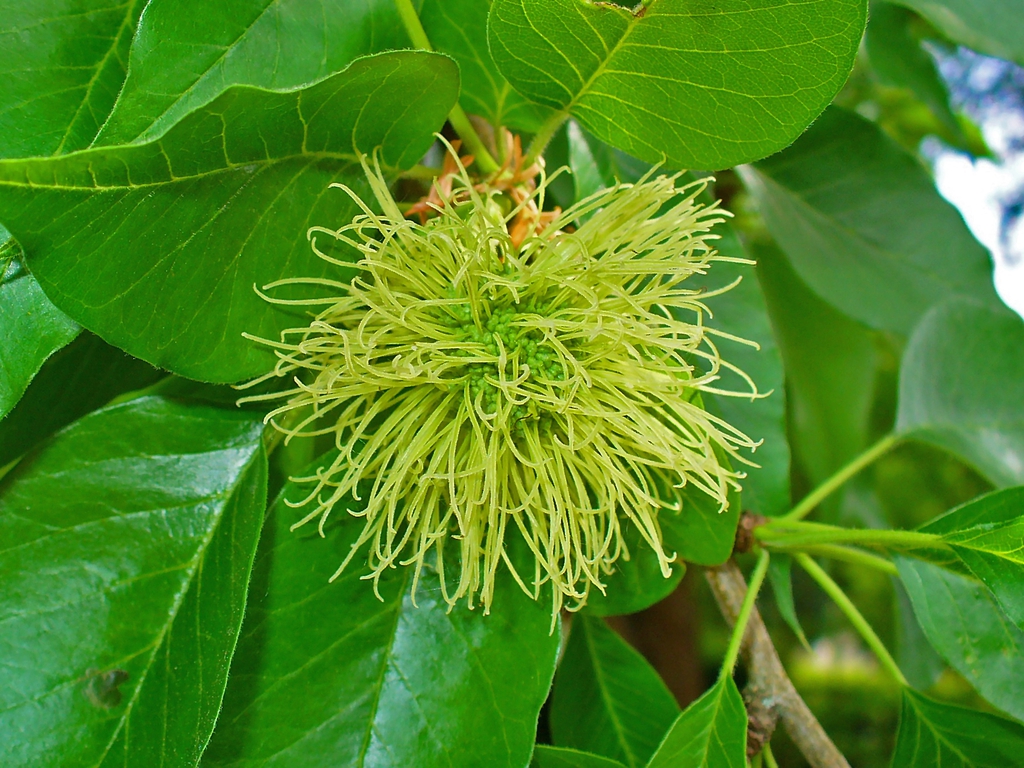
The osage orange tree is a mid-sized, multi-stemmed tree with stout, pointed thorns on its interlacing branches. The leaves on this prickly deciduous tree are lustrous and dark green, with tiny greenish spring blooms. The large grapefruit-like round yellowish-green fruits are a unique feature of this thorny tree.
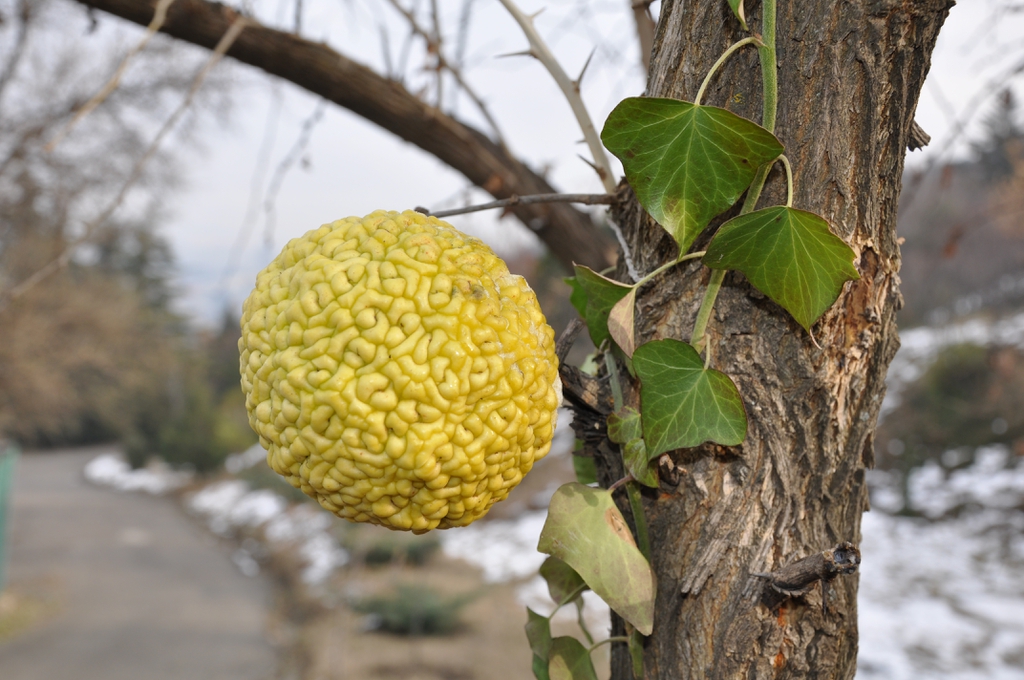
Osage orange trees can reach heights of up to 60 feet (18 meters) and display distinct features such as fruits, leaves, and thorny branches. The tree produces large, round, inedible fruits that are about the size of a baseball. With its sharp thorns, this small shrub-like tree can serve as an effective security hedge or living fence. Osage orange trees thrive best in USDA zones 4 to 9.
To identify Osage orange trees, one can look for their prickly branches, which are adorned with thorns. Additionally, their distinctive large, orange-like fruits and rounded crown contribute to their unique appearance.
Pejibaye (Peach) Palm (Bactris gasipaes)

Pejibaye palm trees are a unique species of palm distinguished by the presence of sharp black spines covering their trunks. These slender palm trees have rounded crowns and feature long pinnate leaves that can reach up to 10 feet (3 meters) in length. The palm fruits of Pejibaye palms come in reddish, orange, or yellow colors.
These palm trees can grow to a height of 66 feet (20 meters) and are known for their clusters of cylindrical yellow inflorescences. They produce large clusters of egg-shaped fruits, about 2.3 inches (6 cm) in length, which have a nutty flavor.
When identifying Pejibaye palm trees, their tall and slender trunks are distinctive, being densely covered in black spines measuring around 2 inches (5 cm) in length.
Pochote (Pachira quinata)

Pochote is a blossoming tree characterized by its thorny trunks and branches, adorned with sharp and stubby thorns. The distinct feature of palmate leaves, composed of five obovate leaflets, sets this tree apart. When in bloom, the pochote tree displays delicate, wiry petals on its flowers, and produces seeds covered in cotton-like hairs.
These spiky trees can reach heights ranging from 20 to 103 feet (6 to 40 meters). Pochote trees, with their thorny nature, exhibit a unique presence in their surroundings.
Pochote leaves and seeds

